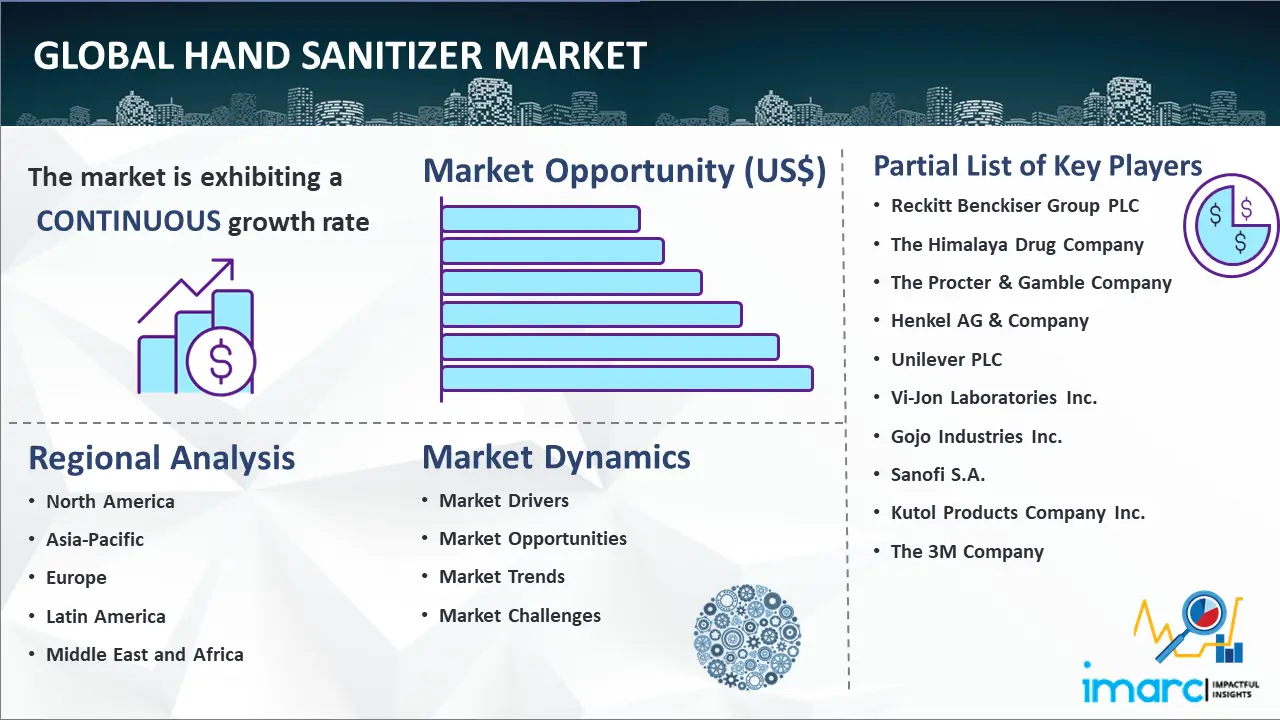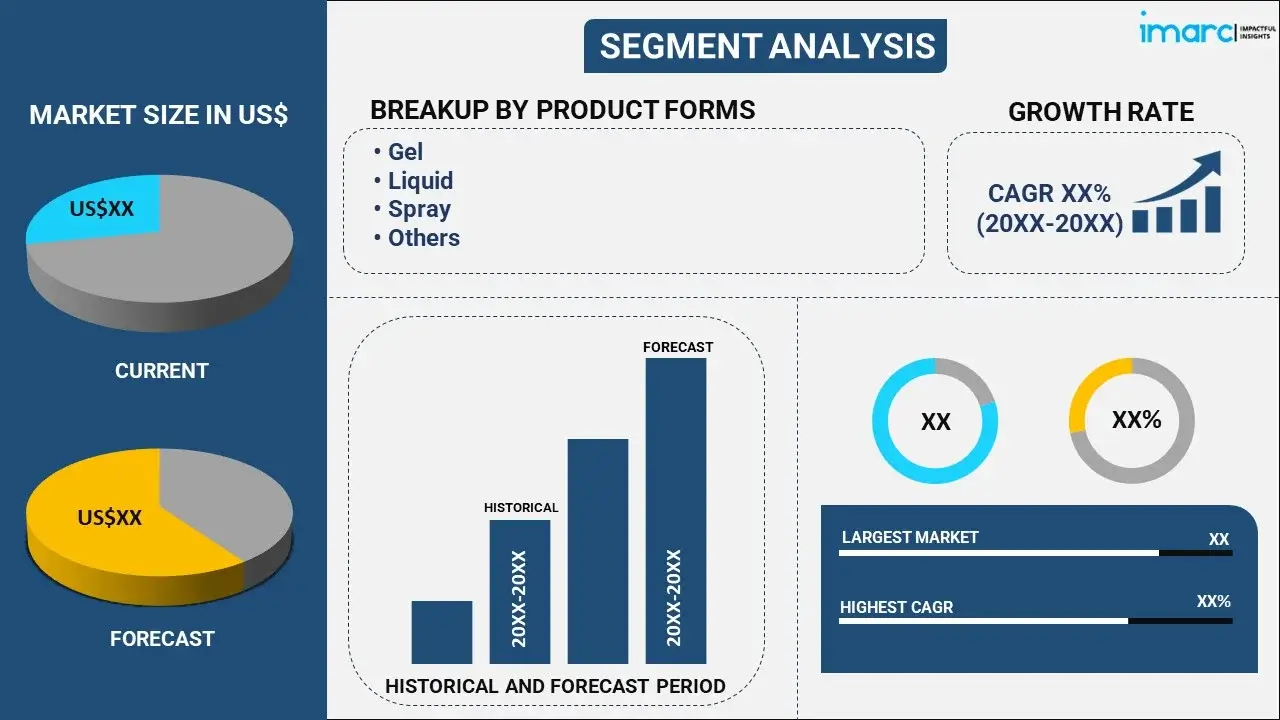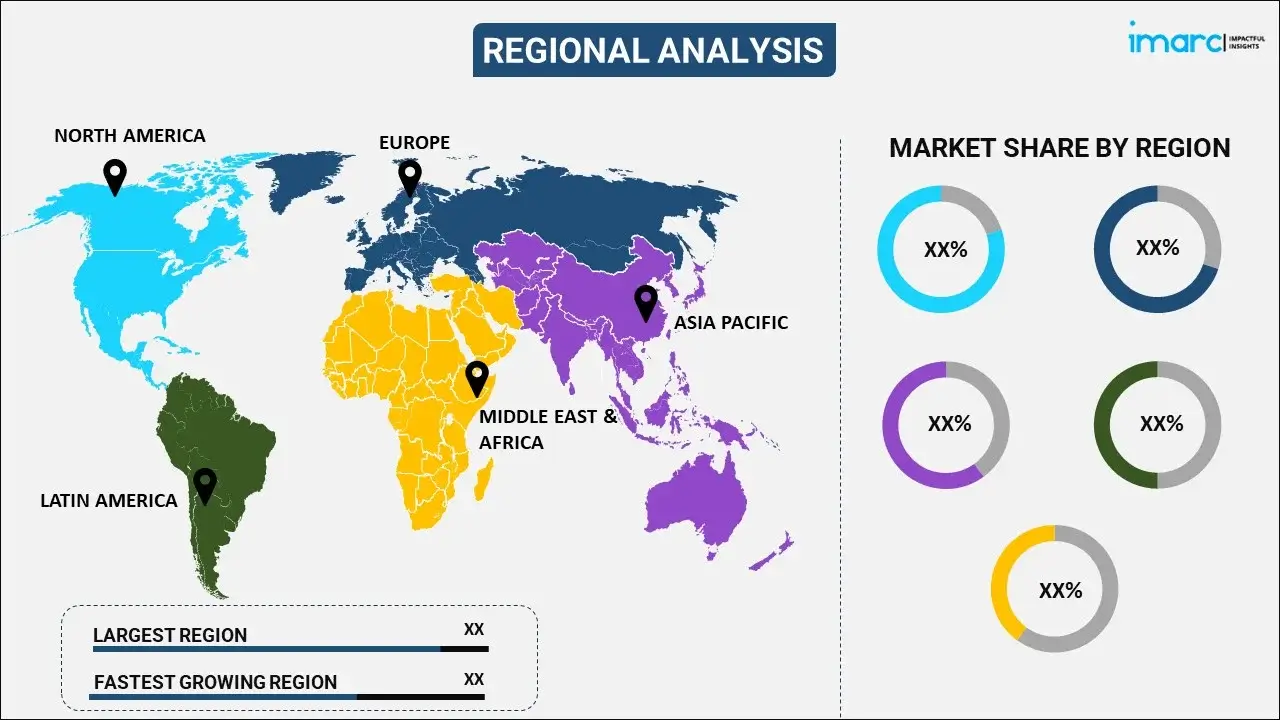IMARC made the whole process easy. Everyone I spoke with via email was polite, easy to deal with, kept their promises regarding delivery timelines and were solutions focused. From my first contact, I was grateful for the professionalism shown by the whole IMARC team. I recommend IMARC to all that need timely, affordable information and advice. My experience with IMARC was excellent and I can not fault it.
Read More
Hand Sanitizer Market Report by Product Form (Gel, Liquid, Spray, Foam, and Others), Product Type (Alcohol-based, Non-alcohol based), Distribution Channel (B2B, Retail), End Use (Hospitals, Households, Manufacturing, Hospitality, Restaurants, Government/Utilities (Except Educational Institutes), Schools and Educational Institutes, Enterprise and Commercial Facilities, Recreational and Entertainment Centers, Agriculture, and Others), and Region 2024-2032
Market Overview:
The global hand sanitizer market size reached US$ 4.9 Billion in 2023. Looking forward, IMARC Group expects the market to reach US$ 3.4 Billion by 2032. The growing health concerns, impact of COVID-19 outbreak, convenience and portability offered by the product, rapidly growing healthcare sector, and increased focus on personal hygiene are some of the major factors propelling the market.
|
Report Attribute
|
Key Statistics
|
|---|---|
|
Base Year
|
2023 |
|
Forecast Years
|
2024-2032
|
|
Historical Years
|
2018-2023
|
| Market Size in 2023 | US$ 4.9 Billion |
| Market Forecast in 2032 | US$ 3.4 Billion |
Hand sanitizer is a disinfectant solution typically composed of alcohol, such as ethanol or isopropyl alcohol, along with other ingredients like water, glycerin, and sometimes fragrances. The primary purpose of hand sanitizer is to kill or inhibit the growth of harmful microorganisms, including bacteria and viruses, on the surface of the skin. It is applied by rubbing a small amount onto one's hands, effectively eliminating potentially harmful germs. Hand sanitizer gained immense popularity, especially during public health crises like the COVID-19 pandemic, due to its convenience and portability. Its effectiveness in reducing the transmission of infectious diseases by hand contact has made it a staple in various settings, including healthcare facilities, schools, offices, and households.

Increasing awareness of the importance of hand hygiene in preventing the spread of infectious diseases, such as COVID-19, has heightened the demand for hand sanitizers. People are more conscious of maintaining clean hands to reduce the risk of illness transmission. Additionally, the COVID-19 pandemic has been a major catalyst for the hand sanitizer market's growth. Governments and health organizations worldwide promoted regular hand sanitization as a preventive measure, leading to a surge in demand for these products. Other than this, hand sanitizers offer a convenient and portable solution for hand hygiene, making them suitable for various settings, including travel, workplaces, and public spaces. The ease of use has contributed to their widespread adoption. Besides this, the healthcare sector has been a key driver of the hand sanitizer market, with healthcare professionals and facilities relying on sanitizers to maintain a sterile environment and reduce the risk of healthcare-associated infections. In line with this, beyond pandemics, a growing emphasis on personal hygiene and cleanliness has driven individuals to incorporate hand sanitizers into their daily routines, even in non-pandemic times. Furthermore, as disposable incomes rise globally, consumers are more willing to invest in health and hygiene products, including premium hand sanitizers that offer added benefits like moisturizing properties and pleasant fragrances.
Hand Sanitizer Market Trends/Drivers:
Increasing Public Health Concerns
Individuals and communities have become increasingly cognizant of the role hand hygiene plays in preventing the spread of infectious diseases. High-profile disease outbreaks, like the COVID-19 pandemic, have underscored the importance of clean hands. As a result, people are actively seeking ways to protect themselves and others, and hand sanitizers have emerged as a convenient solution. This heightened awareness has created a sustained demand for hand sanitizers, even beyond pandemic situations, as people continue to prioritize hand hygiene as a daily habit.
Pandemic Impact
Governments, health organizations, and media outlets worldwide promoted regular hand sanitization as a primary preventive measure against the virus. This led to an exponential surge in demand for hand sanitizers, causing shortages and supply chain challenges initially. The pandemic accelerated the adoption of hand sanitizers not only among individuals but also in various industries, such as healthcare, retail, and hospitality, where hand sanitization stations became ubiquitous. The pandemic's long-lasting effects have reshaped consumer behavior, with many continuing to use hand sanitizers habitually, contributing to sustained market growth.
Convenience and Portability Offered by the Product
These products are easy to carry and can be used without the need for water or towels, making them ideal for on-the-go hand hygiene. The quick-drying nature of hand sanitizers allows people to sanitize their hands in seconds, making it a practical choice in situations where traditional handwashing is not feasible. This convenience has made hand sanitizers a staple in various settings, from public transportation to offices and schools. The ease of use and accessibility have cemented hand sanitizers as an essential part of everyday life, further propelling the market's expansion.
Hand Sanitizer Industry Segmentation:
IMARC Group provides an analysis of the key trends in each segment of the global hand sanitizer market report, along with forecasts at the global, regional, and country levels for 2024-2032. Our report has categorized the market based on the product form, product type, distribution channel, and end use.
Breakup by Product Form:

- Gel
- Liquid
- Spray
- Foam
- Others
Gel hand sanitizer dominates the market
The report has provided a detailed breakup and analysis of the market based on the product form. This includes gel, liquid, spray, foam, and others. According to the report, gel represented the largest segment.
Gel hand sanitizers are known for their user-friendly consistency. They offer a comfortable and familiar texture that people find appealing. This gel-like form is easy to dispense and apply evenly to the hands, ensuring comprehensive coverage, which is crucial for effective hand sanitization. Besides this, gel sanitizers typically contain a higher alcohol content compared to other forms, such as foam or spray. This higher alcohol concentration enhances their germ-killing efficacy, making them more reliable in situations where robust disinfection is required, like healthcare settings or during pandemics. Additionally, gel hand sanitizers often come in convenient packaging, including pump bottles and travel-sized containers. This packaging versatility further boosts their popularity, allowing users to carry them easily and apply as needed in various environments, from workplaces to public spaces. Moreover, the long-lasting familiarity and trust associated with gel hand sanitizers have contributed to their dominance in the market. Consumers tend to stick with products they know and trust, and gel hand sanitizers have a well-established reputation for effectiveness and reliability in promoting hand hygiene.
Breakup by Product Type:
- Alcohol-Based
- Non-Alcohol Based
Alcohol-based hold the largest share in the market
A detailed breakup and analysis of the market based on the product type has also been provided in the report. This includes alcohol-based and non-alcohol based. According to the report, alcohol based accounted for the largest market share.
The primary reason for their dominance is the strong antimicrobial properties of alcohol, specifically ethanol or isopropyl alcohol, which efficiently eliminates a wide range of pathogens upon contact. This effectiveness has been particularly crucial during health crises like the COVID-19 pandemic, where people sought highly reliable hand hygiene solutions. Moreover, alcohol-based sanitizers are recommended and endorsed by health organizations, including the World Health Organization (WHO) and the Centers for Disease Control and Prevention (CDC). These endorsements have bolstered consumer confidence in alcohol-based formulations, further driving their market share. Additionally, alcohol-based hand sanitizers are available in various concentrations, catering to different needs, from everyday use to high-stakes environments like healthcare facilities. Their versatility, coupled with ease of use and rapid drying properties, has made them the preferred choice for individuals, institutions, and industries worldwide.
Breakup by Distribution Channel:
- B2B
- Hospitals
- Other Institutions
- Retail
- Hypermarkets/Supermarkets
- Pharmacy Stores
- Departmental Stores
- Online Stores
- Others
Hand sanitizers are majorly distributed through B2B channel
The report has provided a detailed breakup and analysis of the market based on the distribution channel. This includes B2B (hospitals and other institutions) and retail (hypermarkets/supermarkets, pharmacy stores, department stores, online stores, and others). According to the report, B2B represented the largest segment.
B2B transactions in the hand sanitizer market often involve bulk purchases, catering to the needs of various institutions and industries. Businesses, healthcare facilities, educational institutions, and government organizations require a consistent and substantial supply of hand sanitizers to maintain high standards of hygiene among their employees and patrons. This bulk demand naturally drives up the volume of B2B sales. Additionally, B2B transactions typically involve long-term contracts and partnerships. Suppliers can establish stable and recurring revenue streams by serving businesses and organizations on an ongoing basis, fostering loyalty and trust among their clients. Moreover, B2B distribution channels often offer customized solutions to meet specific institutional requirements, such as tailored formulations, packaging, and delivery schedules. This level of flexibility is essential for addressing the unique needs of different sectors, further solidifying the B2B dominance of the segment.
Breakup by End Use:
- Hospitals
- Households
- Manufacturing
- Hospitality
- Restaurants
- Government/Utilities (Except Educational Institutes)
- Schools and Educational Institutes
- Enterprise and Commercial Facilities
- Recreational and Entertainment Centers
- Agriculture
- Others
Hospitals hold the largest share in the market
A detailed breakup and analysis of the market based on the end use has also been provided in the report. This includes hospitals, households, manufacturing, hospitality, restaurants, government/utilities (except educational institutions), schools and educational institutes, enterprise and commercial facilities, recreational and commercial centers, agriculture, and others. According to the report, hospitals accounted for the largest market share.
Hospitals are environments where stringent infection control measures are of paramount importance. Hand hygiene is a critical component in preventing the spread of infections within healthcare settings. As a result, hospitals have a constant and substantial demand for hand sanitizers to ensure the safety of patients, healthcare providers, and visitors. Additionally, healthcare professionals within hospitals are required to sanitize their hands frequently, often dozens of times per day, as they move between patients and handle medical equipment. This high frequency of use drives a consistent need for readily available hand sanitizers. Furthermore, the adherence of the healthcare sector to stringent regulations and guidelines regarding infection control and patient safety amplifies the importance of hand sanitizers in hospitals. Compliance with these standards necessitates a reliable supply of effective hand hygiene products, further contributing to the segment's dominance.
Breakup by Region:

- North America
- United States
- Canada
- Europe
- Germany
- United Kingdom
- France
- Italy
- Spain
- Russia
- Others
- Asia Pacific
- China
- India
- Japan
- South Korea
- Australia
- Indonesia
- Others
- Latin America
- Brazil
- Mexico
- Others
- Middle East and Africa
North America exhibits a clear dominance in the market
The report has also provided a comprehensive analysis of all the major regional markets, which include North America (the United States and Canada); Europe (Germany, France, the United Kingdom, Italy, Spain, Russia, and others); Asia Pacific (China, Japan, India, South Korea, Australia, Indonesia, and others); Latin America (Brazil, Mexico, and others); and the Middle East and Africa. According to the report, North America accounted for the largest market share.
North America has experienced a heightened awareness of hand hygiene and its role in preventing the spread of diseases. This awareness was significantly amplified by the outbreak of the COVID-19 pandemic, leading to a substantial surge in demand for hand sanitizers. Additionally, the North American healthcare system is one of the most advanced and expansive globally. Hospitals, clinics, and healthcare facilities are prolific in this region, necessitating a continuous supply of hand sanitizers to maintain stringent hygiene standards. Furthermore, North America boasts a robust manufacturing and distribution infrastructure, allowing for the efficient production and widespread availability of hand sanitizers. This infrastructure has enabled quick responses to spikes in demand during health crises, further solidifying the region's position as a leading market for these products.
Competitive Landscape:
Leading companies have continuously invested in research and development to create innovative hand sanitizer formulations. These innovations include products with added moisturizers, natural ingredients, and varying alcohol concentrations to cater to diverse consumer preferences. Product differentiation has allowed companies to capture a broader market share. Additionally, in response to surges in demand, especially during the COVID-19 pandemic, major players ramped up their production capacities. They invested in new manufacturing facilities and streamlined production processes to meet the growing need for hand sanitizers efficiently. Other than this, companies have formed strategic partnerships with distributors, retailers, and other organizations to expand their market reach. These collaborations have helped ensure widespread distribution and availability of their products in various retail outlets and industries. Besides this, key players have invested heavily in marketing and branding efforts to build consumer trust and brand recognition. This includes advertising campaigns emphasizing the effectiveness and safety of their hand sanitizers, as well as aligning their brands with public health initiatives.
The market research report has provided a comprehensive analysis of the competitive landscape in the market. Detailed profiles of all major companies have also been provided. Some of the key players in the market include:
- Reckitt Benckiser Group PLC
- The Himalaya Drug Company
- The Procter & Gamble Company
- Henkel AG & Company
- Unilever PLC
- Vi-Jon Laboratories Inc.
- Gojo Industries Inc.
- Sanofi S.A.
- Kutol Products Company Inc.
- The 3M Company
Recent Developments:
- Reckitt Benckiser Group plc. has recently unveiled a strategic collaboration with the renowned Hilton chain of hotels, introducing the Hilton CleanStay initiative. This noteworthy partnership involves two of Reckitt Benckiser Group plc.'s distinguished brands, Lysol and Dettol, which will be working closely with the esteemed Mayo Clinic's Infection Prevention and Control team. The primary objective of this collaboration is to elevate and fortify Hilton's existing cleaning and disinfection protocols.
- Procter & Gamble (P&G) has taken proactive measures to address the critical shortage of essential hygiene products during the global pandemic. The company, known for its commitment to consumer well-being, has initiated the production of hand sanitizers and masks specifically targeting commercial customers. These products are marketed under the trusted Safeguard brand, which is owned and managed by Procter & Gamble.
- Henkel AG & Co. has demonstrated its unwavering commitment to stand in solidarity with those affected by the global pandemic by launching a comprehensive global solidarity program. This initiative extends its support to not only its employees but also customers and communities facing the challenges brought about by the pandemic.
Hand Sanitizer Market Report Scope:
| Report Features | Details |
|---|---|
| Base Year of the Analysis | 2023 |
| Historical Period | 2018-2023 |
| Forecast Period | 2024-2032 |
| Units | US$ Billion |
| Scope of the Report | Exploration of Historical Trends and Market Outlook, Industry Catalysts and Challenges, Segment-Wise Historical and Predictive Market Assessment:
|
| Product Forms Covered | Gel, Liquid, Spray, Foam, Others |
| Product Types Covered | Alcohol-Based, Non-Alcohol Based |
| Distribution Channels Covered |
|
| End Uses Covered | Hospitals, Households, Manufacturing, Hospitality, Restaurants, Government/Utilities (Except, Educational Institutes), Schools and Educational Institutes, Enterprise and Commercial Facilities, Recreational and Entertainment Centers, Agriculture, Others |
| Regions Covered | Asia Pacific, Europe, North America, Latin America, Middle East and Africa |
| Countries Covered | United States, Canada, Germany, France, United Kingdom, Italy, Spain, Russia, China, Japan, India, South Korea, Australia, Indonesia, Brazil, Mexico |
| Companies Covered | Reckitt Benckiser Group PLC, The Himalaya Drug Company, The Procter & Gamble Company, Henkel AG & Company, Unilever PLC, Vi-Jon Laboratories Inc., Gojo Industries, Inc., Sanofi S.A., Kutol Products Company, Inc., and The 3M Company, etc. |
| Customization Scope | 10% Free Customization |
| Report Price and Purchase Option | Single User License: US$ 3899 Five User License: US$ 4899 Corporate License: US$ 5899 |
| Post-Sale Analyst Support | 10-12 Weeks |
| Delivery Format | PDF and Excel through Email (We can also provide the editable version of the report in PPT/Word format on special request) |
Key Benefits for Stakeholders:
- IMARC’s industry report offers a comprehensive quantitative analysis of various market segments, historical and current market trends, market forecasts, and dynamics of the hand sanitizer market from 2018-2032.
- The research report provides the latest information on the market drivers, challenges, and opportunities in the global hand sanitizer market.
- The study maps the leading, as well as the fastest-growing, regional markets. It further enables stakeholders to identify the key country-level markets within each region.
- Porter's five forces analysis assist stakeholders in assessing the impact of new entrants, competitive rivalry, supplier power, buyer power, and the threat of substitution. It helps stakeholders to analyze the level of competition within the hand sanitizer industry and its attractiveness.
- Competitive landscape allows stakeholders to understand their competitive environment and provides an insight into the current positions of key players in the market.
The global hand sanitizer market was valued at US$ 4.9 Billion in 2023.
The global hand sanitizer market is expected to reach a value of US$ 3.4 Billion by 2032.
The emerging trend of fragrant hand sanitizers with natural and eco-friendly ingredients to maintain hand hygiene is primarily driving the global hand sanitizer market.
The sudden outbreak of the COVID-19 pandemic has led to the growing adoption of hand sanitizers across several nations among individuals as an effective and necessary measure to prevent the further transmission of the coronavirus infection.
Based on the product form, the global hand sanitizer market has been divided into gel, liquid, spray, foam, and others. Among these, gel form exhibits a clear dominance in the market.
Based on the product type, the global hand sanitizer market can be categorized into alcohol-based and non-alcohol based, where alcohol-based hand sanitizer currently holds the majority of the total market share.
Based on the distribution channel, the global hand sanitizer market has been segmented into B2B and retail. Currently, B2B channel represents the largest market share.
Based on the end use, the global hand sanitizer market can be bifurcated into hospitals, households, manufacturing, hospitality, restaurants, government/utilities (except educational institutes), schools and educational institutes, enterprise and commercial facilities, recreational and entertainment centers, agriculture, and others. Among these, hospitals currently account for the majority of the global market share.
On a regional level, the market has been classified into North America, Europe, Asia Pacific, Middle East and Africa, and Latin America, where North America currently dominates the global market.
Some of the major players in the global hand sanitizer market include Reckitt Benckiser Group PLC, The Himalaya Drug Company, The Procter & Gamble Company, Henkel AG & Company, Unilever PLC, Vi-Jon Laboratories Inc., Gojo Industries, Inc., Sanofi S.A., Kutol Products Company, Inc., and The 3M Company.
Need more help?
- Speak to our experienced analysts for insights on the current market scenarios.
- Include additional segments and countries to customize the report as per your requirement.
- Gain an unparalleled competitive advantage in your domain by understanding how to utilize the report and positively impacting your operations and revenue.
- For further assistance, please connect with our analysts.

Purchase options
Benefits of Customization
Personalize this research
Triangulate with your data
Get data as per your format and definition
Gain a deeper dive into a specific application, geography, customer, or competitor
Any level of personalization
Get in Touch With Us

UNITED STATES
Phone: +1-631-791-1145

INDIA
Phone: +91-120-433-0800

UNITED KINGDOM
Phone: +44-753-713-2163
Email: sales@imarcgroup.com
 Inquire Before Buying
Inquire Before Buying Speak to an Analyst
Speak to an Analyst  Request Brochure
Request Brochure  Request Customization
Request Customization



.webp)




.webp)
